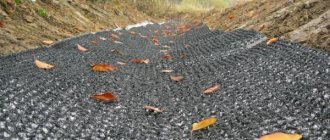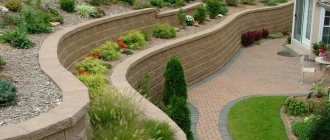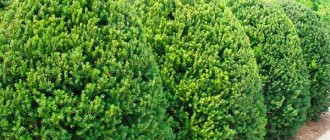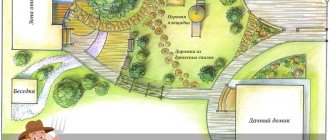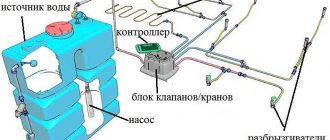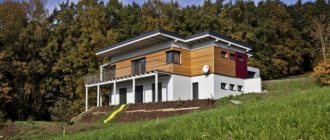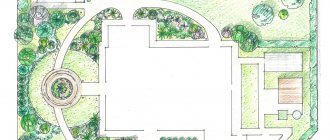Dacha plots can be of the most intricate shape, not only in terms of their borders, but also in terms of topography. Often, these are not just flat areas on which you can build houses and plant plants, but also not particularly convenient ones, with hills, slopes and even serious cliffs.
If we talk about the standard six hundred square meters within the boundaries of the cooperative, then practically no such problems arise, but if the dacha is located outside the city, then it is often built near a forest or river. But here the terrain can change very much. That is why DachaDecor.ru today talks about the topic of slopes and slopes that need to be strengthened.
Why strengthen slopes and slopes?
Many people have avoided this task for years, and nothing... that’s what those who are used to living in the classic dacha mode will say - coming here in the summer to plant potatoes, and leaving in the fall with the harvest, until spring. Well, we are a little different, and our dacha should not only be productive, but also very attractive. And also convenient, safe and extremely practical. This means that everything that we build, create and even plant should be useful for many years. And sometimes this requires additional care.
Strengthening slopes, slopes and banks is one of these concerns, especially for summer residents who own areas with difficult terrain. Here, there may be slides of soil, slides from the top point and directly into the yard or garden, erosion of the bank and washing out of the same lawn, melting of snow into a mud pile during the spring melt, and breakdown of plants. These are just a couple of reasons that already draw attention to the complexity of the problem. But it also happens that not only does a snow cap fall from a steep hill at a dacha, bringing with it a little dirt and roots, but also multi-ton, extremely dangerous landslides that we would like to prevent.
It is clear that such precedents take place in mountainous areas, or in areas of forested areas and even former construction sites, where there are hills, ravines, pits and other non-standards that lead away from a simple and flat topography. But at our dachas there are also places that should be treated with caution. Therefore, let's study methods that will help qualitatively strengthen the slopes with our own hands.
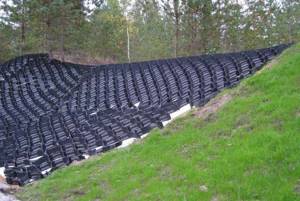
What and how to strengthen the slope
ways to strengthen the slope of a site .
The choice of one method or another depends on the magnitude of the slope, the nature of the terrain, and the presence of groundwater. Small slopes (less than 8%) can be strengthened by planting plants. If this is not possible, try digging concrete or wooden blocks into the soil. With the help of such devices you can perfectly decorate your garden plot. Slopes of more than 8% are reinforced with special devices, such as: geogrid, geogrid, geomats, geotextiles. When installing them, it is not necessary to resort to the help of professionals; you can do it yourself. Methods, as a rule, can be combined with each other, which will only increase their effectiveness. For example, plants can be planted on almost every geomaterial.
Let's take a closer look at each of the materials and tell you how to lay them with your own hands.
How to strengthen a small slope with plants
If the slope does not exceed 8-10%, it is most advisable to strengthen it with plants with a strong root system. Thanks to the planting of grasses, cereals, shrubs and small trees, living soil reinforcement is created inside the soil, which prevents landslides and unauthorized distortion of the relief.
In this regard, you should not remove plants on slopes, if there are any in your dacha. At first, after uprooting, changes may be observed, as you will disrupt the soil bond. But problems may arise in the future, when a lack of plants gives problem areas the opportunity to quickly deteriorate.
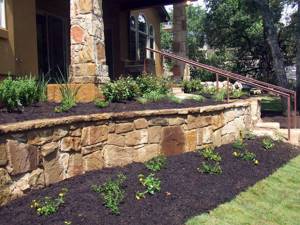
Ways to strengthen a slope
There are many ways to strengthen a slope. It is impossible to say with certainty that any of them is definitely better. Much depends on the angle at which your site is located and the prevailing soil type.
- A plot with a ravine - refuse to buy or try to beat it?
A ravine can become both a curse and a decoration of the site. Is it worth getting involved in such a controversial enterprise and how to minimize the risks?
The easiest way to strengthen a slope is to plant plants with a strong root system. Green plantings, growing, will strengthen the soil with their roots and prevent it from moving down.
- 6 beautiful plants to strengthen slopes
We choose the right plants to strengthen the slope.
However, this method is only suitable for areas where the hill is located at a slight angle. For areas with a slope exceeding 10 degrees, more reliable methods are needed. These include strengthening the slope with various geosynthetic materials (geomaterials):
- geotextiles;
- geomatom;
- geogrid;
- geogrid.
All these words with the first part geo- are building materials made from natural or synthetic polymers. They are used to improve the properties of various types of soil, protect soils from erosion and serve to protect areas that need slope strengthening. These products are not afraid of moisture, temperature changes and chemicals. They have a long service life, are environmentally friendly and do not cause installation difficulties.
Strengthening with biomats
Plants can also be used to secure slopes up to 45%, but there are much more risks here. They exist because plants take a long time to form a root system, which must reinforce the soil. Atmospheric factors also work here - the presence of precipitation, wind, humidity associated with bodies of water located nearby or on the slope itself, as well as the groundwater level and even tremors.
Therefore, it is recommended to use additional reinforcement in the form of biomats, which consist of coconut fibers or straw applied to a layer of cellulose.
Biomats are laid on the surface of the cleaned slope and evenly fixed. Next, seeds of various plants are sown over the entire area of the material, which in the near future should create a single layer with the biomats. These can be not only special flowers and herbs, but also plants for landscape design of your dacha area that you yourself have chosen.
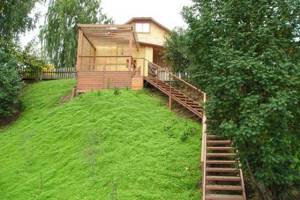
Strengthening slopes with plants
At an angle of inclination not exceeding 8-10 degrees, in order to stabilize the soil cover, you can plant plants: trees, shrubs, flowers and herbs, the flexible roots of which can penetrate deeply into the soil, protecting it from landslides and erosion. Trees have a powerful root system, however, you should not plant only large plants on the entire slope.
Compositions that are free-standing low trees and shrubs look more attractive. To decorate the steep edges of ravines, you can plant broom, elderberry, viburnum, Japanese quince, mackerel, barberry, cotoneaster or rosehip bushes on them.
They perfectly strengthen slopes by planting ground cover plants, and the color variety and difference in height will help hide some of the imperfections of the relief. Thanks to the uneven relief, you can create real picturesque masterpieces of decorative art by combining stones of various shapes, bright and beautiful flowers and water flowing along the ledges.
Decorative elements are made in the form of flowering bushes and plants with long shoots and lush flowers, among which climbing roses are especially beautiful. But it is not recommended to make too bright cocktails from climbing plants. It is enough to plant 1-2 beautifully flowering species.
Sloping surfaces can be decorated with groundcovers such as periwinkle, woolly cherry, ivy and sunflower, creating dense carpets and providing a backdrop for larger plants.
Owners of land plots who prefer to equip them with alpine slides and rockeries will be pleased with the uneven terrain, which has elevations, ledges and depressions. It costs nothing for craftsmen to use a bunch of stones, several coniferous trees and different types of flowers to create a wonderful decoration for their summer cottage. But before setting up a flower garden, you need to think about creating favorable growing conditions - ensuring regular watering of the plants.
Fixation with geotextiles
Geotextile is a dense material based on polyester or polypropylene fibers. It is artificial, but is excellent for a wide variety of jobs, as it is quite durable and water permeable.
Thanks to geotextiles, it is possible to strengthen slopes of 173% or 60°. Geotextiles are laid out along the slope and subsequently reinforced with special anchors. After final installation and fixation, you can always plant plants on top of the material, or decorate the slope with stone, gravel, or tiles.
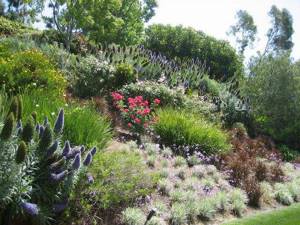
Strengthening with geomats
Another way to make a high-quality and reliable slope is the use of geomats. This material, which consists of several layers of polypropylene gratings, even somewhat resembles a washcloth.
But the positive side is that, along with high strength, geomats are also permeable to air, water and plant roots. That is, laying geomats on a slope will not only qualitatively strengthen it, but also, as in previous cases, plant all the necessary plants on top of the material, which will soon create a uniform and fairly dense layer.
An additional advantage of the material is the ability to use it on slopes up to 70°.
Self-strengthening the hillside at the dacha
If the land plot is located in a lowland or ravine, there is a considerable risk of it being flooded with soggy soil during heavy rains. Such unique mini-mudflows can flow down the slopes and destroy crops planted in the garden, covering them with a layer of viscous clay. To avoid such a disaster, you need to strengthen the slopes of your garden and country estate in advance.
Nowadays, this problem is solved with the help of concrete boxes, slabs, gabions, metal, plastic meshes and volumetric gratings that protect slopes, as well as the walls of ditches and ditches. The simplest way to protect a cuvette from erosion is to install special boxes or plates on its walls. This can be either a concrete structure or a gabion - a box made of metal mesh filled with pebbles, crushed stones or stones.
To strengthen the slope of a ravine , concrete slabs are laid at the bottom of the ditch and secured with metal anchors and pins. Now melt and rain water will flow over this surface without eroding the relief. In addition, all inclined walls of the ditch should be reinforced with pebbles or decorative stones, fastened into blocks like gabions. The thickness of the resulting structures is about 5-10 cm, and metal anchors are also used to fix them.
To preserve turf located on hillsides, you can create a bonding canvas from lawn or garden mesh. These metal products are attached to the ground with pins (pegs). If the height of the slope exceeds 2-3 meters with a slope of more than 45 degrees, it is necessary to carry out preliminary excavation work to drain water from the upper level of the canal and secure the soil on the slope. To do this, you need to remove the existing turf from the walls, level and compact the soil, and then lay a metal mesh on top, to which rectangular or square pieces of new soil are attached.
If desired, you can use additional fasteners in the form of metal anchors, which will allow you to press the new turf more tightly to the old soil and create a single canvas of green grass interspersed with ornamental plants and flowers on the slope.
Geotextiles and geogrids are an excellent addition to concrete slabs and metal mesh
Another option for protecting slopes is to level the soil and lay drainage geotextiles on it. And on top are placed flat blocks of metal wire, inside of which there is gravel. After securing with steel anchors, fertile soil containing lawn grass seeds is poured into the gravel. To revive the resulting green canvas, you can arrange flower beds in several places, which will diversify the appearance of the area. And the base of the slope will need to be equipped with a drainage system made of concrete slabs.
Over the past few years, the demand for volumetric gratings has increased, which make it possible to strengthen even the steepest slopes and slopes. These products are polymer strips welded together in a checkerboard pattern. This lattice is stretched, laid on the surface of the slope and secured with L-shaped pegs or anchors. And all its cells are filled with soil or crushed stone. If you add lawn grass seeds to the soil, it will soon sprout and take root, which will quickly cover the cellular structure and make the structure more durable. In addition, the volumetric lattice will protect the lawn located on the slope from moles, which constantly dig their passages in the ground and spoil the grass cover with their molehills. Thanks to the fine-mesh grid, moles will lose access to the surface and will eventually leave the area.
Features of working with geogrid
The first stage of work is always leveling the top layer of soil on which the grid will be laid. The soil can be compacted using a vibrating plate or a hand roller. When this work is completed, a layer of non-woven geotextile can be laid, which will play an important role in the drainage of surface water. The height of the geogrid ribs laid on geotextiles depends entirely on the steepness of the slope. All component modules of the product must be stretched and fixed with L-shaped steel anchors. During this process, it is necessary to control the uniformity of the tension of the modules, and sew individual grids with a staple gun or connect them with U-shaped anchors.
The correct design of the geogrid requires that it extend above the top of the slope by at least half a meter, after which the product must be buried again in the ground. When the grid is finally fixed, you can fill its cells with soil, sand, gravel or crushed stone. The procedure should be performed from top to bottom along the entire height of the created structure.
Modern geogrids are made from durable materials such as polyethylene and polypropylene, which allows them to be successfully used in many civil engineering techniques. The technology is based on the adhesion of the granular structure of filler substances to the cells of the product. The result is a wedging effect that resists horizontal shear of soil masses and at the same time mobilizes the bearing capacity of the soil.
Application areas of geogrid
- Using this material, you can reinforce slopes of increased steepness, as well as fix the slopes of highways. Thanks to filling with permeable substances, the resulting structure increases the resistance of slopes to surface erosion. And the presence of an appropriate level of humidity inside it allows the growth of various types of vegetation, which not only takes root, but also improves the appearance of the area.
- The geogrid filled with crushed stone ensures reliable fixation of the cushion on many types of road surfaces. Thus, horizontal spreading of main tracks is eliminated. It is known that the design of such work is carried out taking into account the conditions of soil load-bearing capacity required in each specific case. And builders often have to replace soil in order to increase its load-carrying capacity, for which a separate cost item is included in the estimate. So, you can avoid expensive soil replacement with the help of a geogrid filled with earth, because its use allows you to halve the thickness of a standard replacement.
- This product ensures the stability and strength of the slopes of small watercourses, strengthening the entire coastal zone. Its use contributes to landscaping, additional drainage of the area, as well as reducing losses associated with landslides, landslides and bank deformation. The use of geogrids in the construction of watercourses allows saving base filler and creating an ideal surface under the waterproof layer.
- One of the main problems of railway construction is the movement and deformation of slopes and embankments along which trains move. Under the pressure of passing trains, the rails are displaced, and the railway tracks have to be closed for long-term repairs. It is the geogrid that makes it possible to significantly reduce the time of repair work and quickly fix railway cones.
- Using these products, it is also possible to construct retaining walls of various heights and any angle. In this case, filling with sand or crushed stone must be accompanied by layer-by-layer compaction.
Operation of the load distribution mechanism
With the help of geogrids, modern builders can effectively reinforce the soil by forming 100, 150 or 200 mm thick slabs on its surface. Moreover, the transfer of load, which is caused by the movement of cars, occurs in several stages. First, vehicle wheels create vertical stress in the soil masses that are located in the geogrid cells. Because of this, the pressure on the cell walls begins to increase. Therefore, one part of the load is taken by the elastic tape from which the product is made, and the rest is transferred to adjacent cells.
Due to the fact that the cells are interconnected, the geogrid allows the stress to be distributed horizontally over a large surface of the soil at once. Therefore, the magnitude of the vertical load is reduced, and this is a very important factor for weak soil. Thus, during construction it is possible to use soil with poor load-carrying capacity, provided it is strengthened with a geogrid. Another advantage is that adjacent cells limit each other's movement, so uneven settlement of the structure is completely eliminated.
Go to section: Landscape materials and landscaping elements
Application of geogrid
The geogrid allows you to work with exactly the same angle. It is a material made of polyester or glass, which is quite easy to work with.
Geogrid will help to quickly compact the top layer of soil, which is most susceptible to landslides and various types of destruction, as well as decorate it after major work.
The geogrid is laid in the following way: initially, the material itself is laid on a more or less prepared surface. Next, soil, sand or even crushed stone is poured into the geogrid cells. But it is most correct to place fertile soil in the cells, where plants can be planted immediately. This will make it possible to obtain the highest degree of strength of the slope strengthening in just a few months.
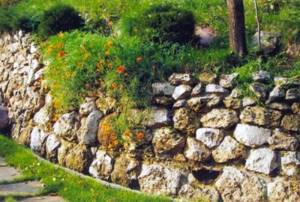
Strengthening the slope with geogrid
If the slope of your site exceeds 70 degrees, experts recommend using geogrid as a reinforcing material. This polymer material is similar to a large honeycomb, which is filled with various materials during operation. Laying of the geogrid occurs in a certain sequence in several stages.
Stage 1
First, it is necessary to clear the ground of large plants, stones, debris, holes, etc., level and, if necessary, compact the slope. The root system of plants is not removed, because it serves to hold the soil together.
Stage 2
Spread geotextiles on the slope and stretch them well. This layer is needed to prevent the soil from mixing with the material that will subsequently fill the geogrid cells. Geotextiles will also help if water is oozing from the slope. The material simply will not allow it to reach the surface and erode the top layer of soil, but will distribute the liquid over its surface and direct it down to the foot of the slope.
Stage 3
Attach anchors to the geotextile. The distance between them should not exceed 21 cm for a fine-mesh geogrid and 40 cm for a coarse-mesh geogrid. It is the anchors that are needed to hold this material.
Stage 4
Stretch the geogrid on the slope, securing it with anchors. To obtain a solid canvas, connect individual sections of the geogrid to each other with an industrial stapler.
Remember that a properly laid and stretched geogrid should have square cells.
Stage 5
Next comes filling the cells with pre-selected material. For this, crushed stone or fertile soil is usually used. Mineral filler - sand or crushed stone - is poured 3 cm above the edge. The soil should rise 5 cm above the geogrid.
Application of geogrid
Experts say that geogrid is more reliable in use than geogrid. This material is a cellular frame that stretches over the surface. After laying on a slope, the geogrid can be fixed in different ways, but the most popular is fixation with fillers. What’s interesting is that almost anything can be used – soil, sand, pebbles, crushed stone.
Further landscaping is also possible, but, as you understand, this is possible with the use of almost any material to strengthen slopes and slopes.
We strengthen the slopes with gabions
We have already talked about this topic, and also studied gabions in detail in other articles. We never cease to be amazed at the possibilities of simple metal structures filled with various materials inside. They are assembled quite simply, and can even be made independently in a summer cottage.
Regardless of the slope, gabion structures become reliable reinforcements. Only the initial condition of the problem area, as well as its height, plays a role. The larger it is, the more difficult the task ahead, but if we are not talking about mountains, but a simple dacha terrain, then any problem is reduced to nothing by gabion structures.
You can install gabions vertically or lay them at the desired angle. But it is worth remembering that they have sufficient weight not only to restrain collapsing plumbs, but also to independently slide along the surface at an angle. Therefore, it is worth reliably strengthening each structure, creating a support in the form of a foundation under the lowest one.
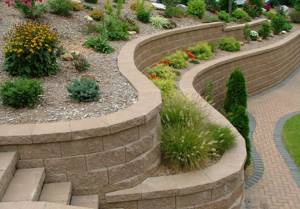
Slopes and retaining walls
We will not dwell on this section for long, since an interesting thematic article has already been written on the topic. Let us only point out the fact that retaining walls are an excellent choice for a summer resident who has decided to combine “repairing” the soil with decorating the site. It is also worth adding that they should only be used for slopes of low height, with low soil pressure.
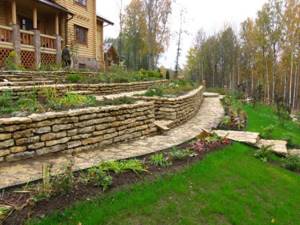
Other options for strengthening slopes, slopes and banks
Often the situation itself dictates to us the choice of materials for work and the solution to the problem. The reasons may be money, time, available materials, the condition of the site, its height, distance from buildings, bodies of water, or the need to combine complex work and decoration. Therefore, it is necessary to have many options at hand, by assessing the features of which it will be possible to determine the most suitable one:
- If your dacha has a difficult terrain area, its boundaries can be strictly defined by trees. Over the course of several years, their root system will “bind” a solid foundation, thanks to which the slope will remain in the state we need for a long time. But remember that fixing with biomats while planting trees will provide a good safety net;
- Strengthening the required slopes can also be done with the help of logs that are dug to the required depth. Each individual case requires accurate calculations, and therefore we are not ready to state the values for the installation depth and diameter of the log... it’s just one of the good ways;
- It is also convenient to make a sloping slope in the form of steps by installing the same gabions or retaining walls sequentially, for example, along the slope every few meters. This way you will secure the area and install an original shaped design at your dacha;
- Partial fastening with geomaterials is also possible, which are selected depending on the angle of the slope. Small trenches are dug under them, and geomaterial is placed at the bottom. Next, the trench is filled up, and the edge of the material leaves the ground and goes upward, as if hugging all the soil laid in the trench. At a distance of several meters from the trench, that is, above it, the edge is pinned. After just a year, you get a dense layer that is reliable due to the reinforcement with the same mesh and plant roots.
There are many more methods, but today we have described the most popular and used ones. Therefore, take them into service.
Such work with relief is considered complex and therefore requires a serious approach. We recommend drawing up a work plan in advance and making accurate calculations, making sure to select only high-quality and appropriate materials for the soil strengthening process.
